Encounters with Material Culture: Objects and Archeology: Week 8: Coinage
1/108
There's no tags or description
Looks like no tags are added yet.
Name | Mastery | Learn | Test | Matching | Spaced |
|---|
No study sessions yet.
109 Terms
What is numismatics?
"a piece of metal certified by a mark or marks upon it to be of a definite exchange value, and issued by governmental authority to be used as money."
Were coins mass-produced?
Yes, they were mass-produced. One die could produce 20,000-40,000 coins before breaking.
What does it indicate when a hoard of coins are found?
Coins were an important part of everyday life. Often when we find hoards, these are someone’s life savings.
Where is a coins value derived from?
Coins value was driven form the metal and its weight, making it an intrinsic part of their economy.
How were coins made?
Flat piece of metal put in what is essentially an embosser hit by a hammer and both sides would get an image
Draw a hellenistic coin that is labeled:
Why are coins good sources?
1)They present the official line of the state.
2)Coinage offers a more continuous chronological and geographical coverage than any other medium could provide.
3)Coinage has a high survival rate than more perishable materials.
4)coinage is a window of the time. They can give us insight into the views and activities of a broad array of people, many of whom may not be well represented in written histories. They cannot be restrospectively changed.
What do we gain insight into by anakysing the imagery on coins?
By analysing the imagery of coins we gain insight into how a ruler of a city wanted to depict themselves.
What do coins depict?
Coins would depict the political and cultural messages of the upper echelon of the city.
Show a Lydian and Ionian coin from 7th c BCE:
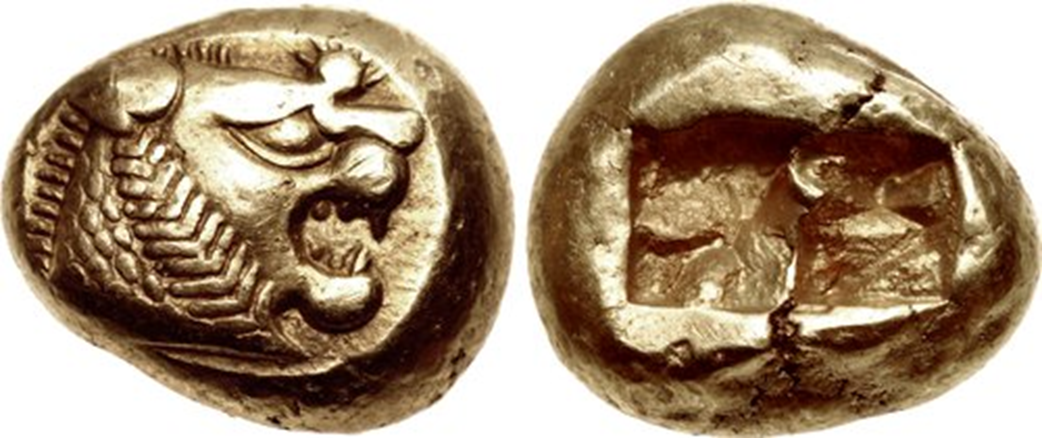
What do we know about this coin?
Alyattes – Kroisos. Circa 610-546 BC. EL Trite – Third Stater (12mm, 4.77 g). Sardes mint. Head of roaring lion right, sun with multiple rays on forehead / Two incuse square punches.
Show the other Lydian and Ionian coin from 7th c BCE:
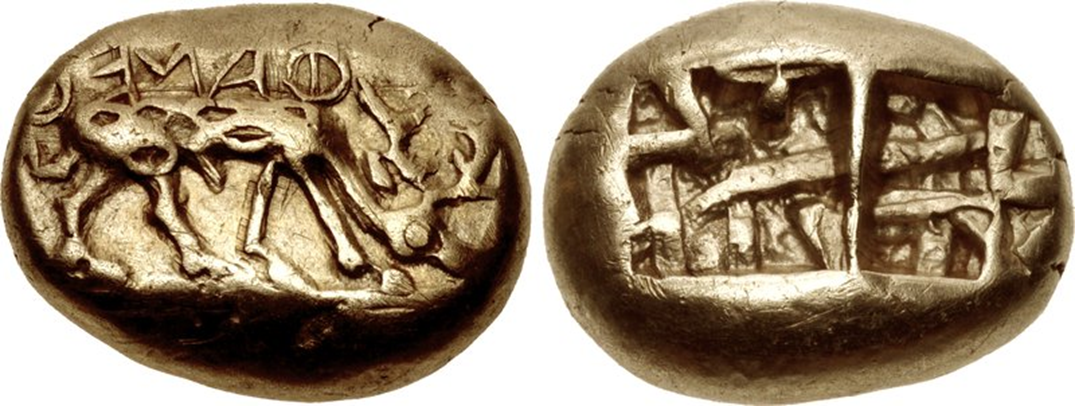
What do we know about this coin?
Electrum coin from Ephesus, 620-600 BC. Obv.: Staggrazing right, ΦΑΝΕΩΣ(retrograde). Rev.: Two incuse punches, each with raised intersecting lines.
What were these coins made from and how were they valued?
•Naturally occurring electrum and controlled electrum.
•Standardised weight but different quantities of gold and silver.
Why did using electrum cause problems?
Using electrum caused problems as it was a mix of gold and silver and some had more silver than gold e.g. they had less value
How did standardisation of coins affect how they were made and how they were valued?
They began to create standradised coins, the stamp was a guarantee of the coins validity
Standardisation improved trade but natural electrum still caused problems as two coins of the same size could have different values. To counteract this issue the people took part in the manufacturing of the metal
What did Lydian coin denominations allow?
Lydian electrum coins have denominations: 3rds, 6ths and 12ths. This made it possible to have large transactions and small ones. This caused a problem as if they are only using electrum some of the coins would be very tiny
What desgns would the Lydians have on their coins?
Other designs included animals, patterns etc. Also acted as early propaganda to strngethen the rulers image
Why did the greeks begin to create their own coins?
Ionian merchants showed the advantage of coins over a weighted system, so the greeks began to create their own coins (allowing trade to flourish between regions)
What did Lydian coins eventually lead to?
Lydian coins eventually led to the widespread use of gold and silver coins
Show the gold bimetallism coin:
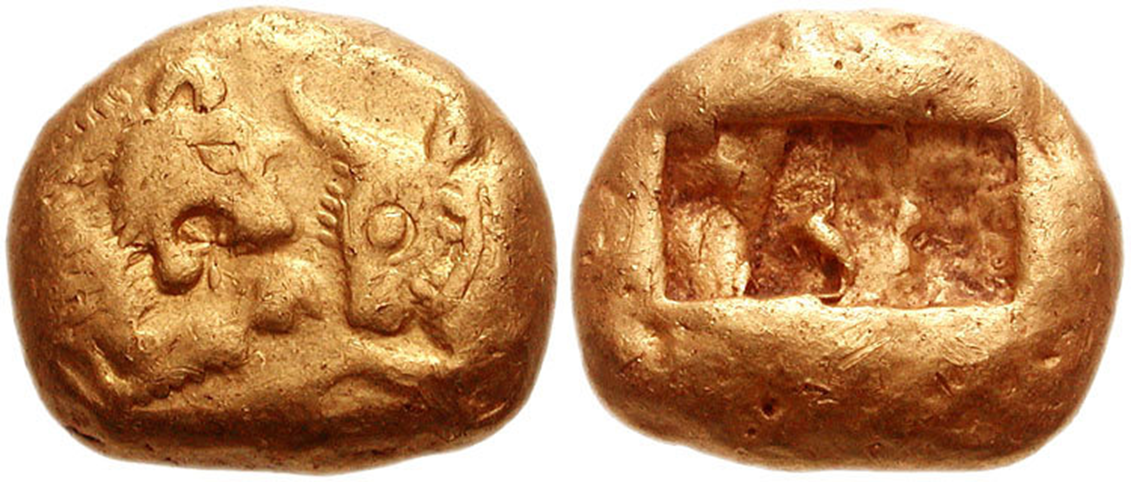
What do we know about this coin?
Gold Croeseid, minted by King Croesusc. 561-546 BC. (10.7 grams, Sardismint).
Show the silver bimetallism coin:
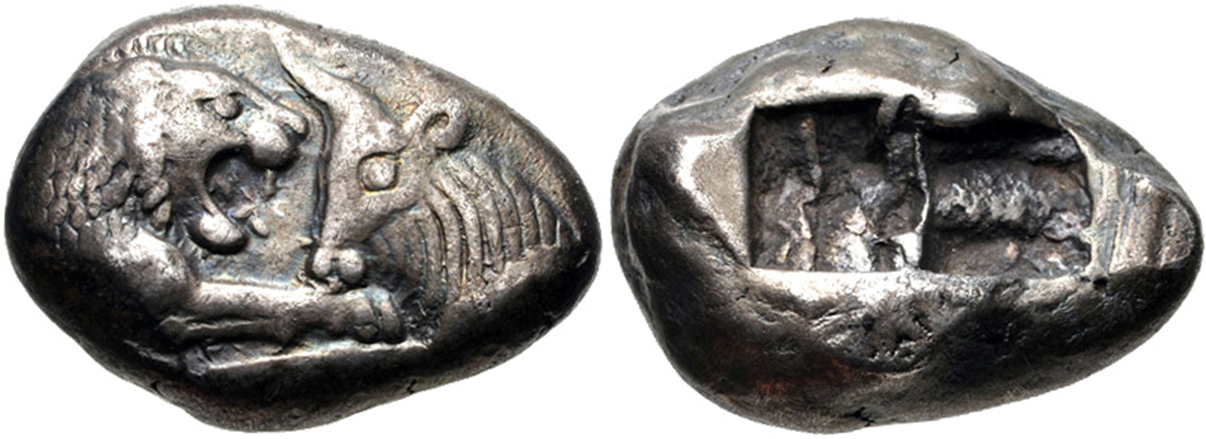
What do we know about this coin?
Silver Croeseid, minted by King Croesus, circa 560-546 BC (10.7 grams, Sardis mint)
What were these two coins made of?
•Pure gold and silver refined from electrum
•Gold and silver (10.7g) – gold later reduced to 8.1g
•Small fractions (smallest is 0.36g)
Was this system of coinage in Lydia effective?
This system was so effective that when the persian empire took over Lydia they kep using the coinage system
Why was the invention of coinage a turning point in economic history?
The invention of coinage was turning point in economic history, it allowed for easier trade
Present the Lydian sea turtle coin:
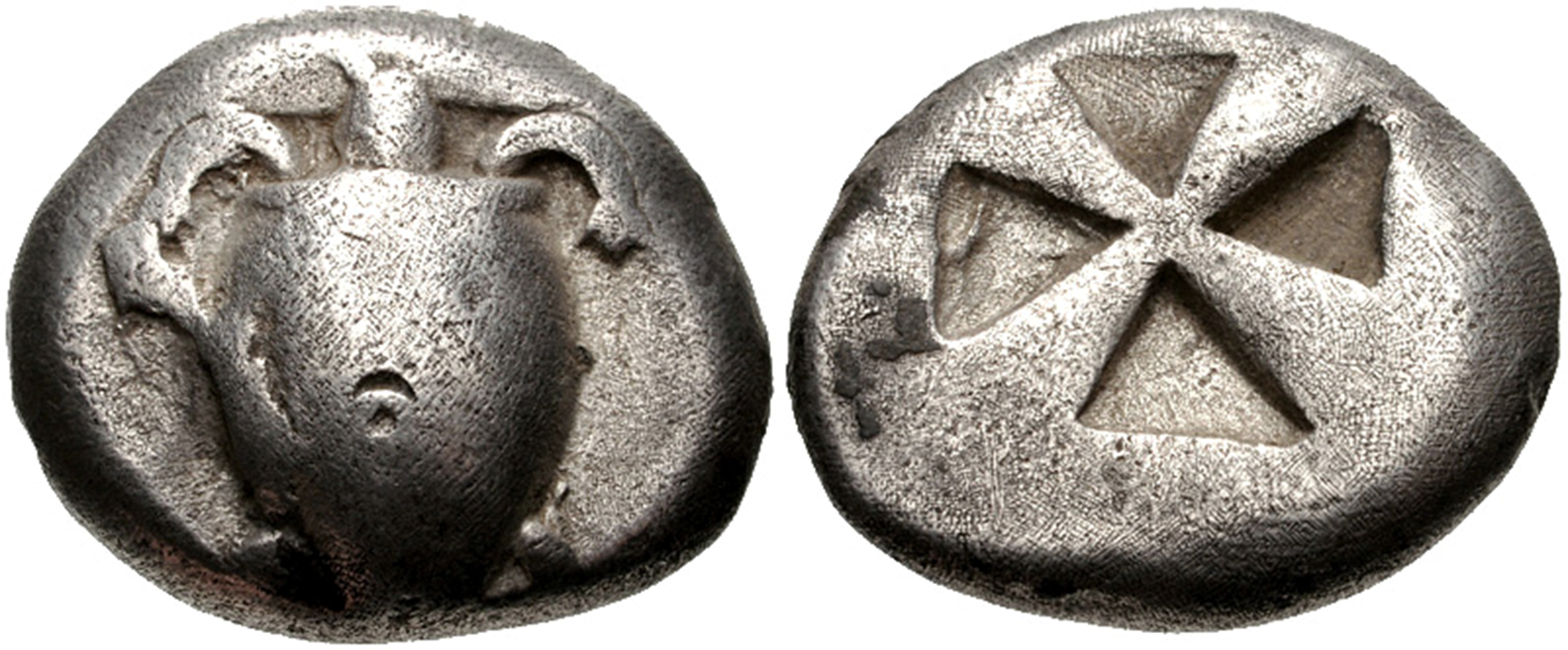
What information do we have about the sea turtle coin?
Archaic Aegina coin type, "windmill pattern" incuse punch. c. 510–490 BC.
Present the lydian coin with a gorgon face on it:
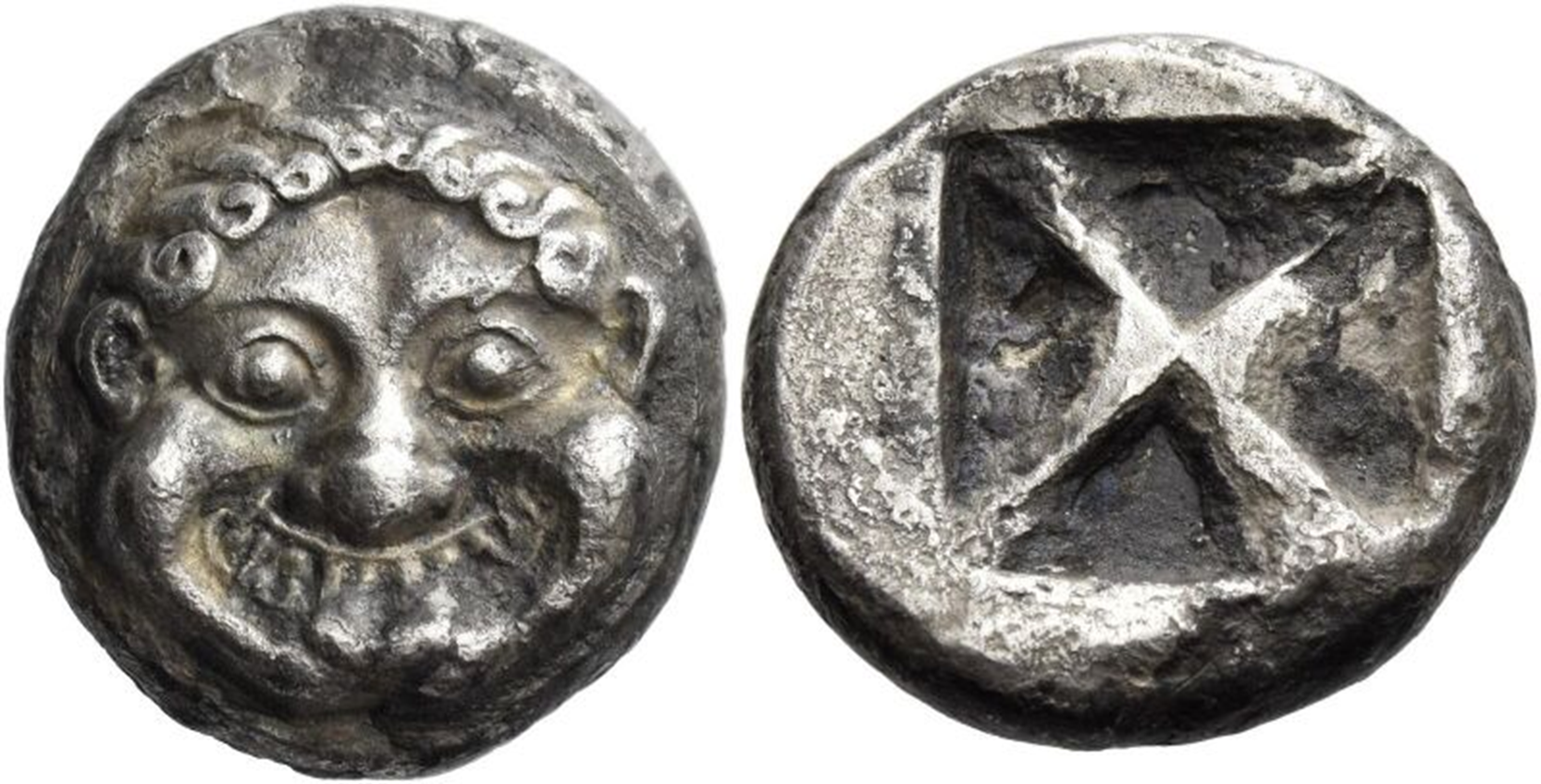
What information do we have about this lydian gorgon face coin?
Athens, AR Didrachm, c. 545-515 BC. Obv: Gorgoneion facing with open mouth and protruding tongue. Rev: Quadripartite incuse square, diagonally divided
What were the main denominations of a classical greek coin?
Main denominations are the Obol, The drachm (six obols) and tetradrachm (four drachms)
What are the primary weight standards of classicla greek coins?
1)Three primary weight standards: Attic; Corinthian; Aeginetan.
2)Most important weight standard for you to remember is the Attic.
How many drachmas is in a mina?
100
How many drachmas is in a talent?
6000
Show an Athenian coin (face and owl)
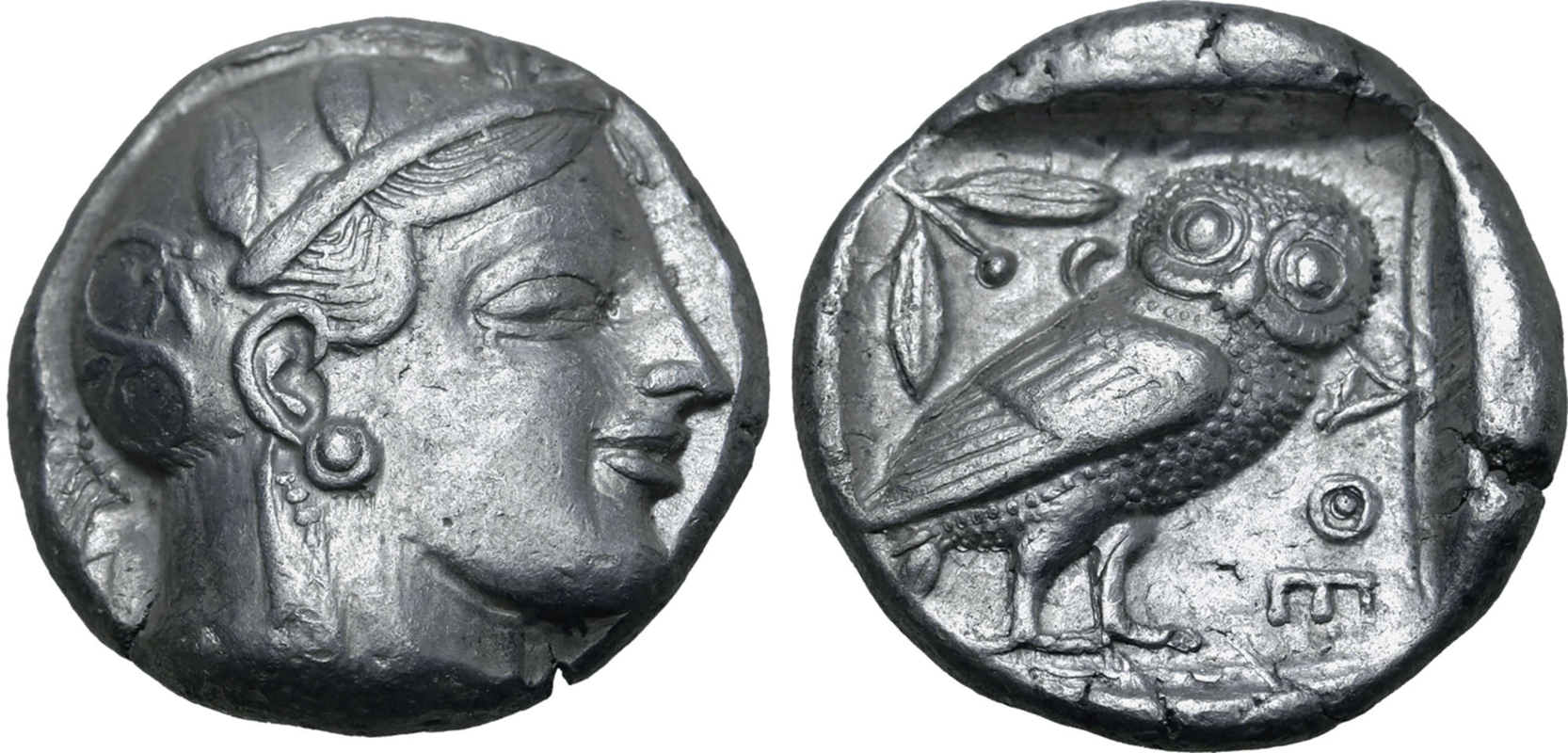
What information do we have on this coin?
Attica, Athens AR Tetradrachm. Circa 460-454 BC. Late "transitional" issue. Head of Athena to right, wearing crested Attic helmet ornamented with three olive leaves above visor and spiral palmette on bowl, round earring with central boss and pearl necklace / Owl standing to right with head facing, olive sprig and crescent behind, ΑΘΕ before; all within incuse square.
What were these coins used for?
These coins were likely used for local transactions
Explain the imagery on this coin and their reason for using it
These coins had distinctly athenian imagery
The owl is called an Attic owl, its the design used on the greek euro today. On the Obverse there is a helmeted Athena. Olive sprig near the owl and the letters spell out Athens
Theyve used Athena on the obverse as they are Athens and the owl and olive sprig are associated with Athena
What did the production of silver athenian coinage go along with?
The large scale production of silver athenian coinage went along with their political situations. Leading up to the Persian war Athens was stock piling their coins. The cities coinage became more dominant after the war
What was the main currency used in the Athenian empire?
The Athenian empire caused athenian silver to be the main currency used in the empire
How standardised did these coins become?
By 455 BC athenian coinage was highly standardised 9 out of 10 surviving coins date from this period, this shows how deeply embedded their money was in society.
Show the Corinth coin:

What information do we have about this coin?
Corinth, AR Stater. Obv: Head of Athena wearing Corinthian helmet with olive-wreath Rev:Pegasos flying l.
What type of coin is this?
This is the fully developed classical type
Describe the images on the coin:
The pegasus is the obverse and athena is the reverse
Athena is wearing a corinthian helmet with a small boar to the right of her (a mint mark)
Symbol beneath the pegasus is called a Kappa an archaic greek letter, their equivalent of a c
When did corinthian coins begin to feature artistic designs?
In early 6th and 7th C BC corinthian coins began to feature artistic designs
Show an image of an Aegian coin:
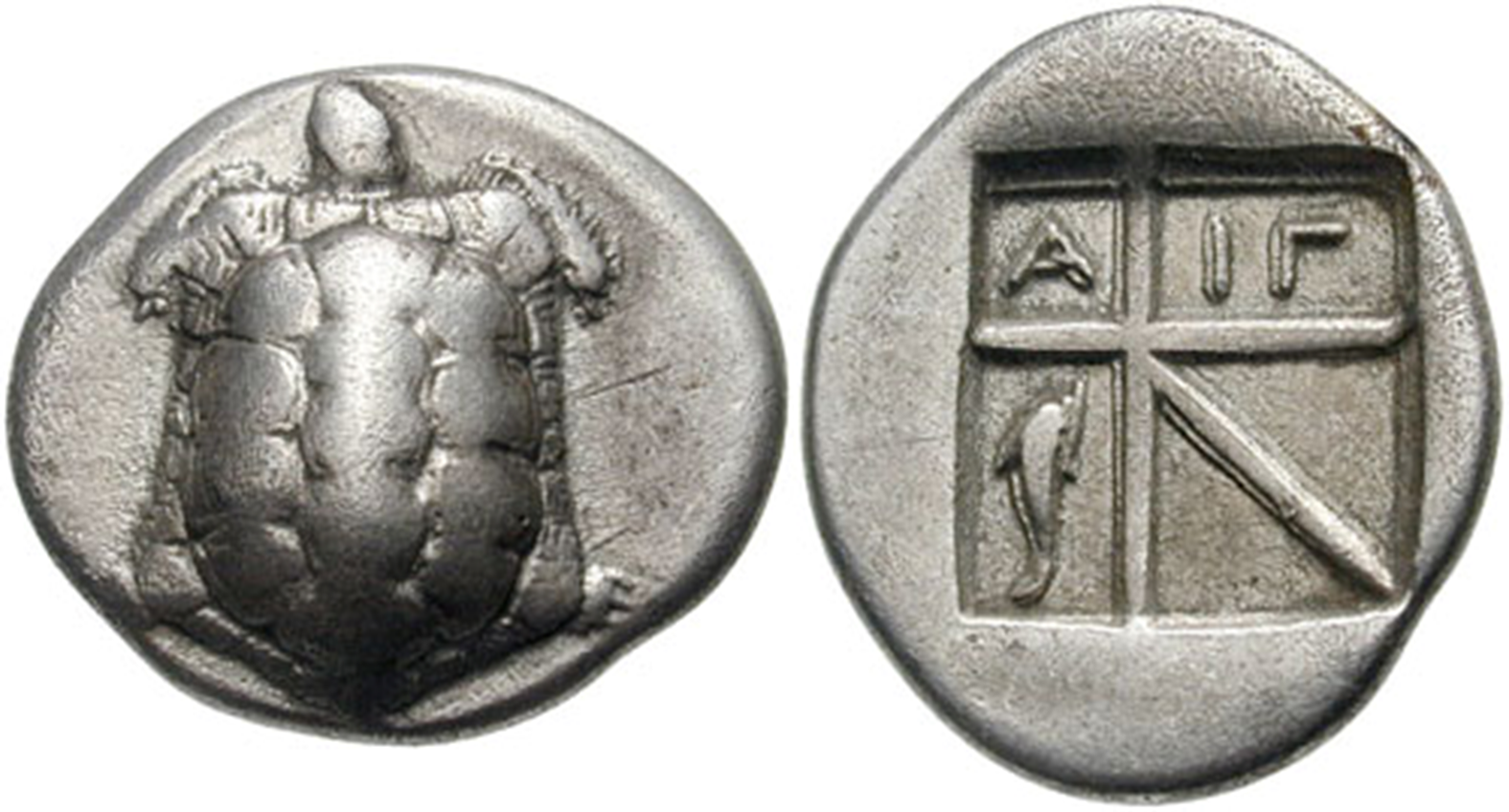
What information do we have about this coin?
AEGINA. After 404 BC. AR Drachm (18mm, 5.43 gm). Land tortoise, head turned, seen from above; [A I] / Incuse, A I G, dolphin in angles. BMC Attica pg. 141, 193. SNG Copenhagen 524.
Show a Rhodos coin:
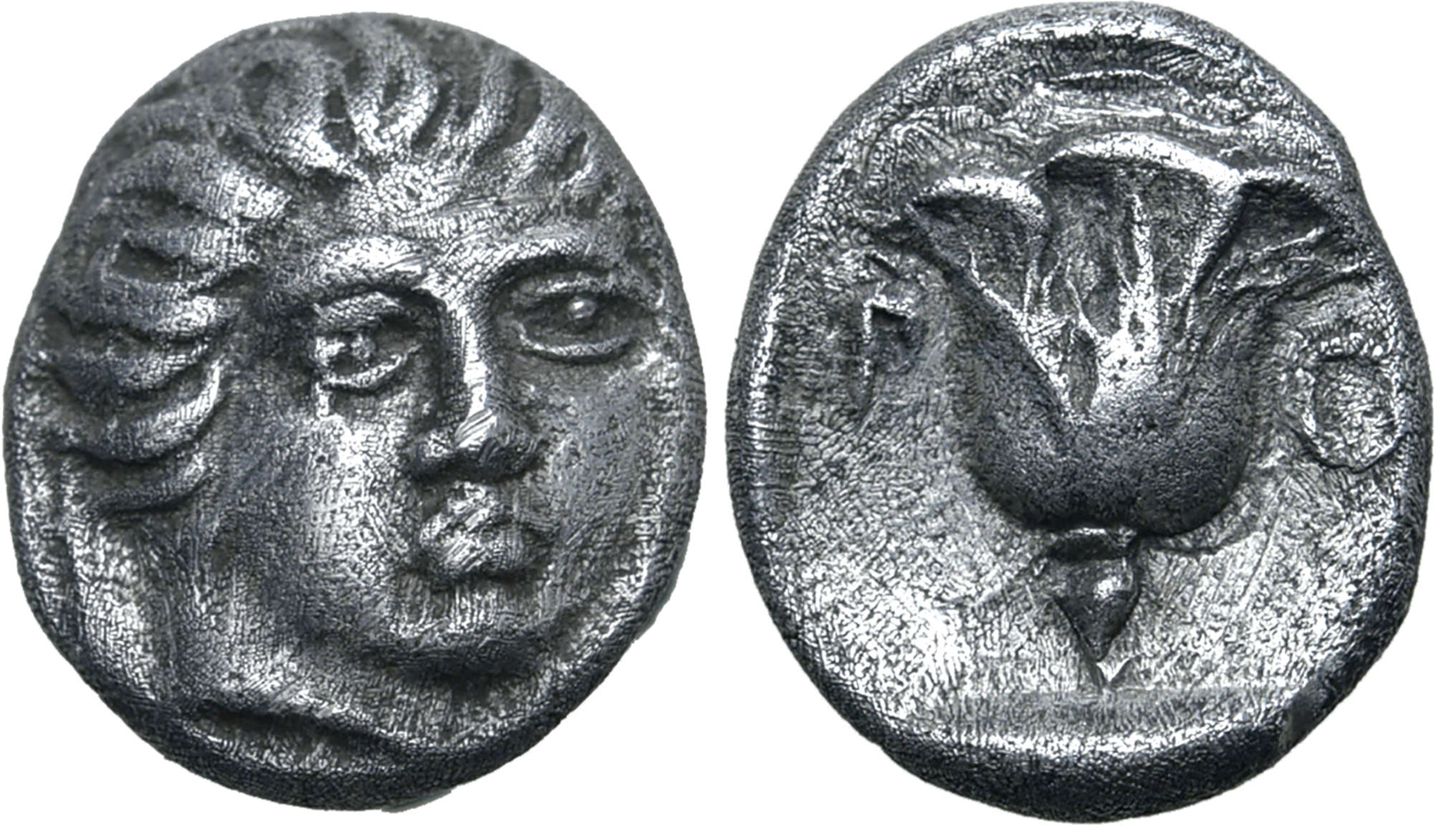
What information do we have about this coin?
Rhodos, Rhodes AR Hemidrachm. Circa 408-390 BC. Helios facing slightly to right / Rose; P-O across fields, all within incuse square. Ashton 19; SNG Copenhagen 725; SNG Keckman 367; HGC 6, 1426. 1.80g, 12mm, 12h.
Show a coin from Knossos:
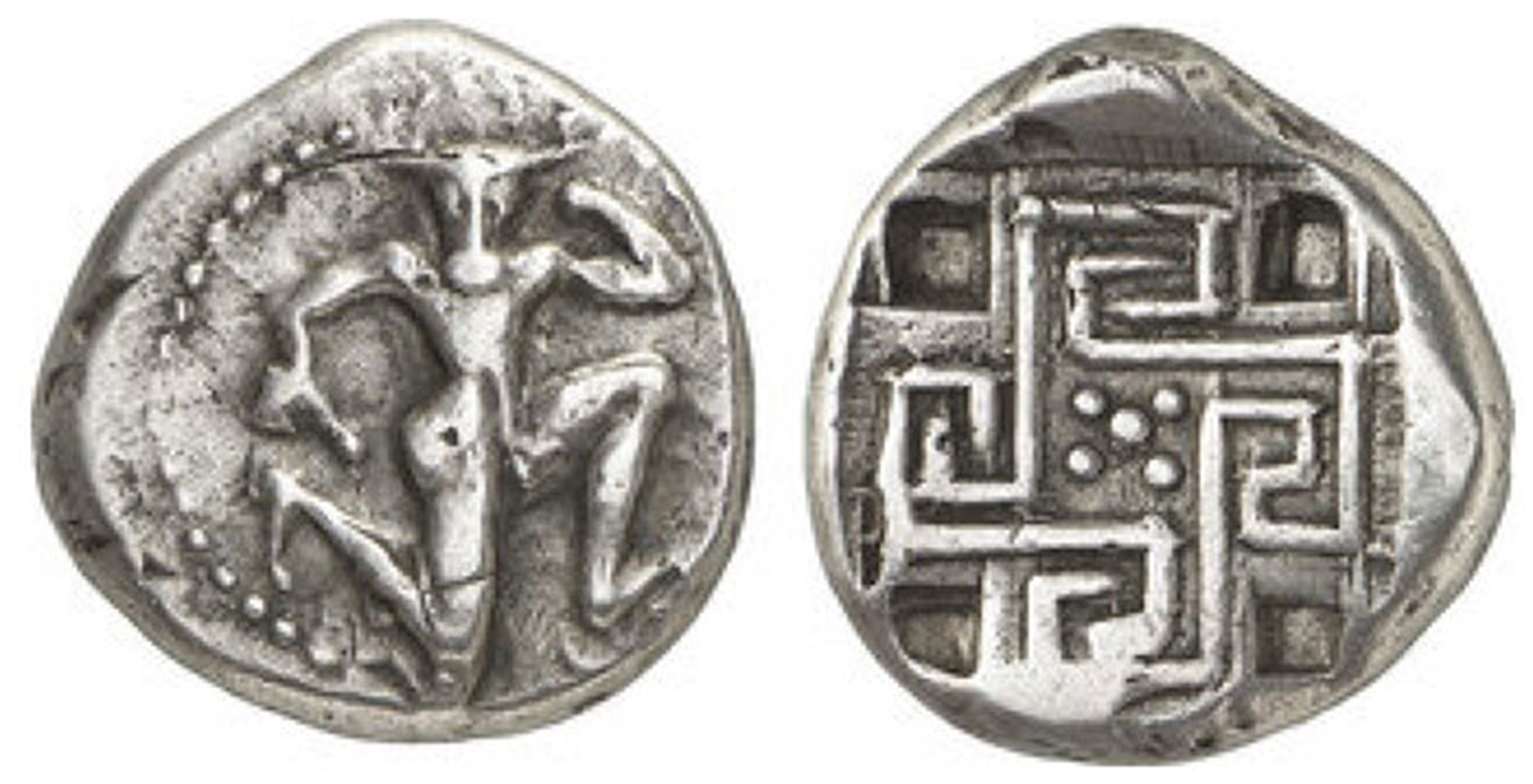
What information do we have about this coin?
RETE, Knossos. Stater (11.93g). about 425 – 360 BCE Vs .: Naked Minotaur in knee walking pattern right. Rev .: Swastika-like labyrinth with five points in the middle. A square recess in each of the four gussets. The undertype is probably a stater from Aegina. Svoronos, Crete 1 Plate. 4. 23 = BMC 1 Plate IV 7
Show the ionian (asia minor) coin:
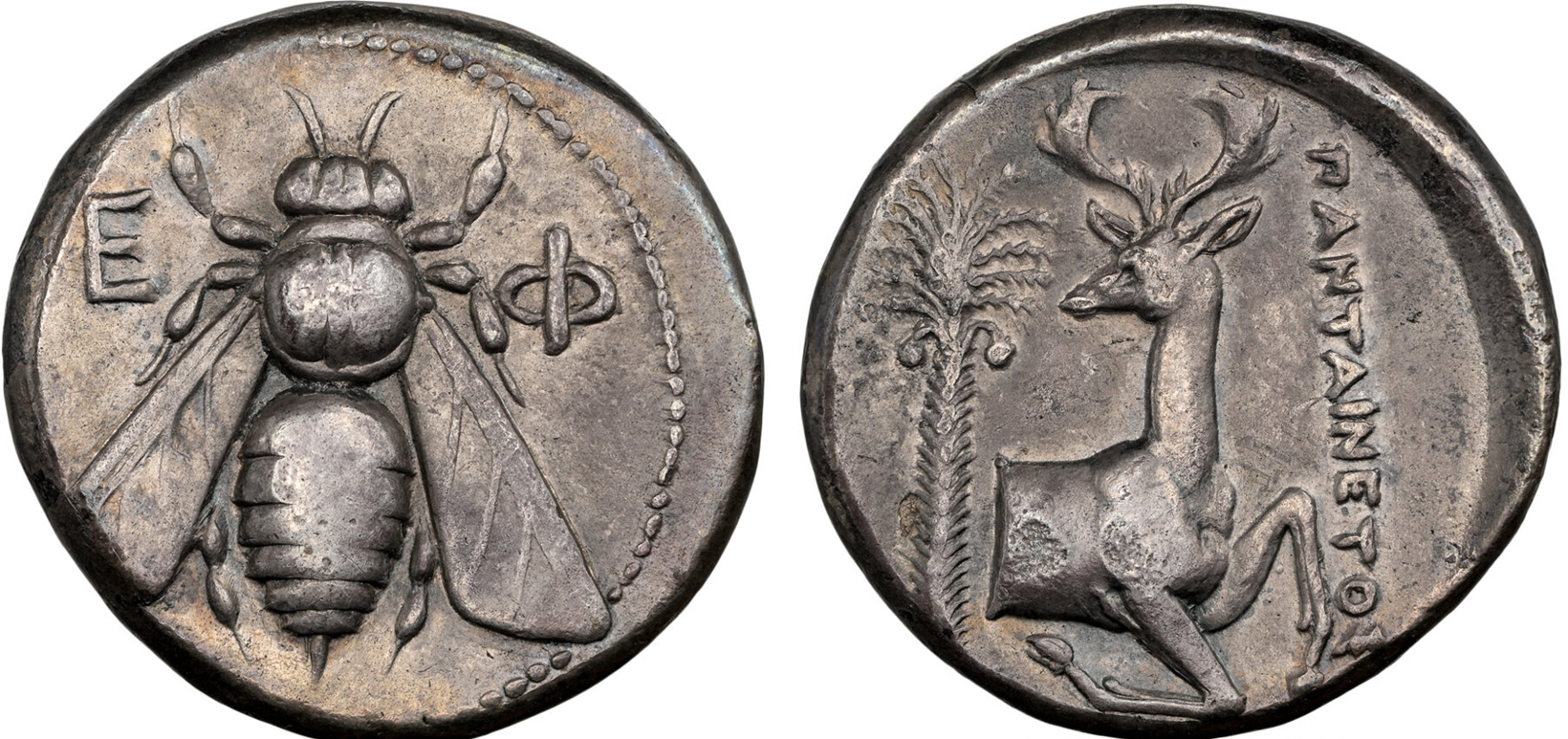
What information do we have about this coin?
IONIA. Ephesus. Ca. 4th century BC. AR tetradrachm (23mm, 15.03 gm, 12h). Ca. 360-350 BC, Pantainetus, magistrate. E-Φ, bee with straight wings seen from above / ΠANTAINETOΣ, forepart of stag kneeling right, head reverted; palm tree behind.
What does the bee and the letter E on the coin stand for?
The bee for Ephesus on the obverse with the letter E to the left
Show the coin from Boeotia:
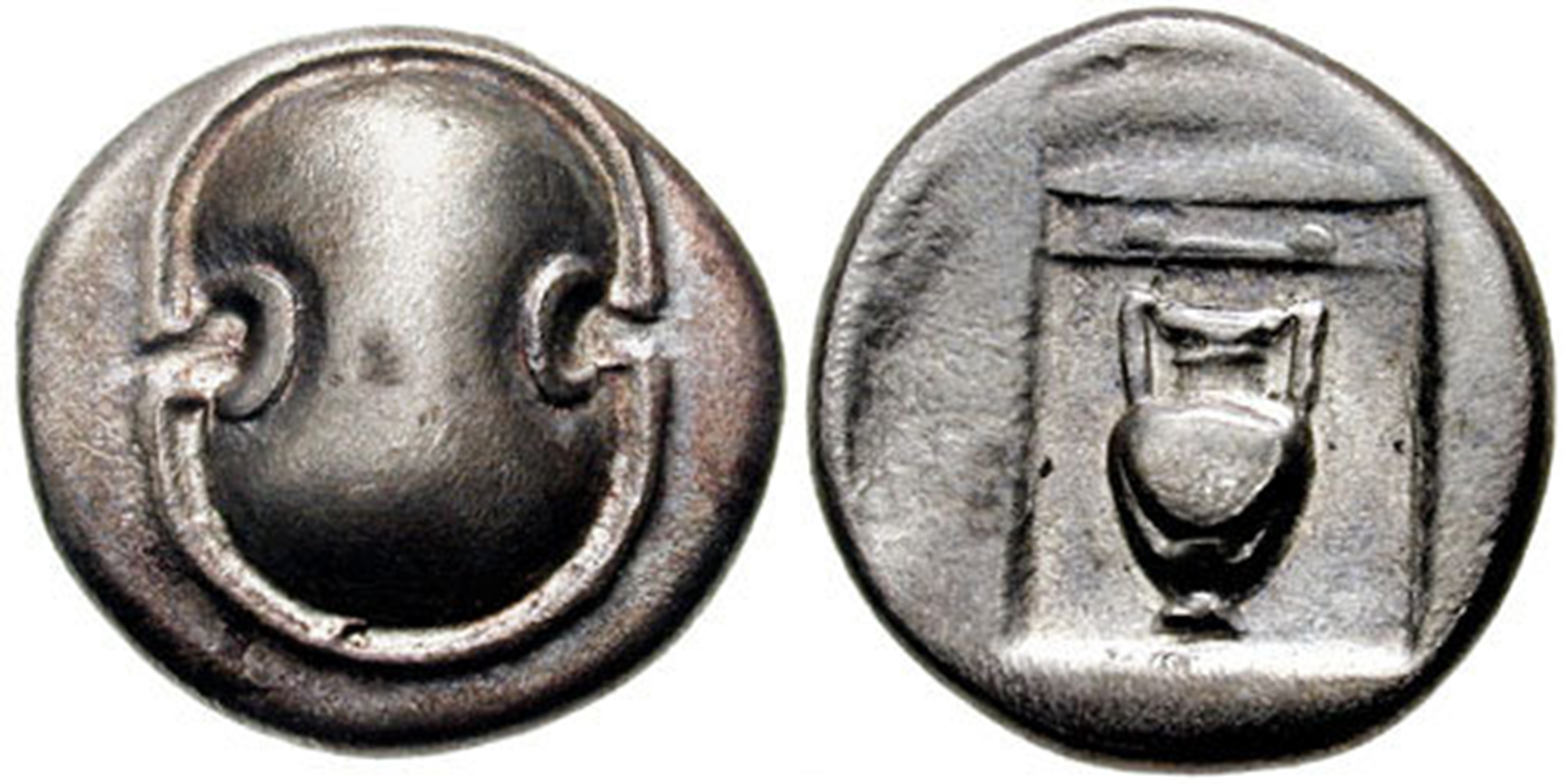
What information do we have about this coin?
Boeotia, Thebes. Circa 480-456 BC.AR Drachm (18mm, 5.56 g).Boiotian shield / Amphora in incuse square.
What do all of these coins depict?
All of these coins depict things close to their local identity whether its a foundation myth or a symbol relevant to the cities identity
What changed for coinage in the hellnistic period?
Introduction of portraiture onto ancient coinage
It was unheard of for a greek ruler to be placed on a coin, it was the place of the gods
The shift came in the Hellenistic period
Explain Alexanders connection to coinage:
When Alexander took the throne he took on a long history of coinage with kings/ruler on it. He claimed to be descended from Heracles
Alexander introduced his own coins a long time after his father had died and after a victory he won at war
What did the coin of Alexander the great look like?
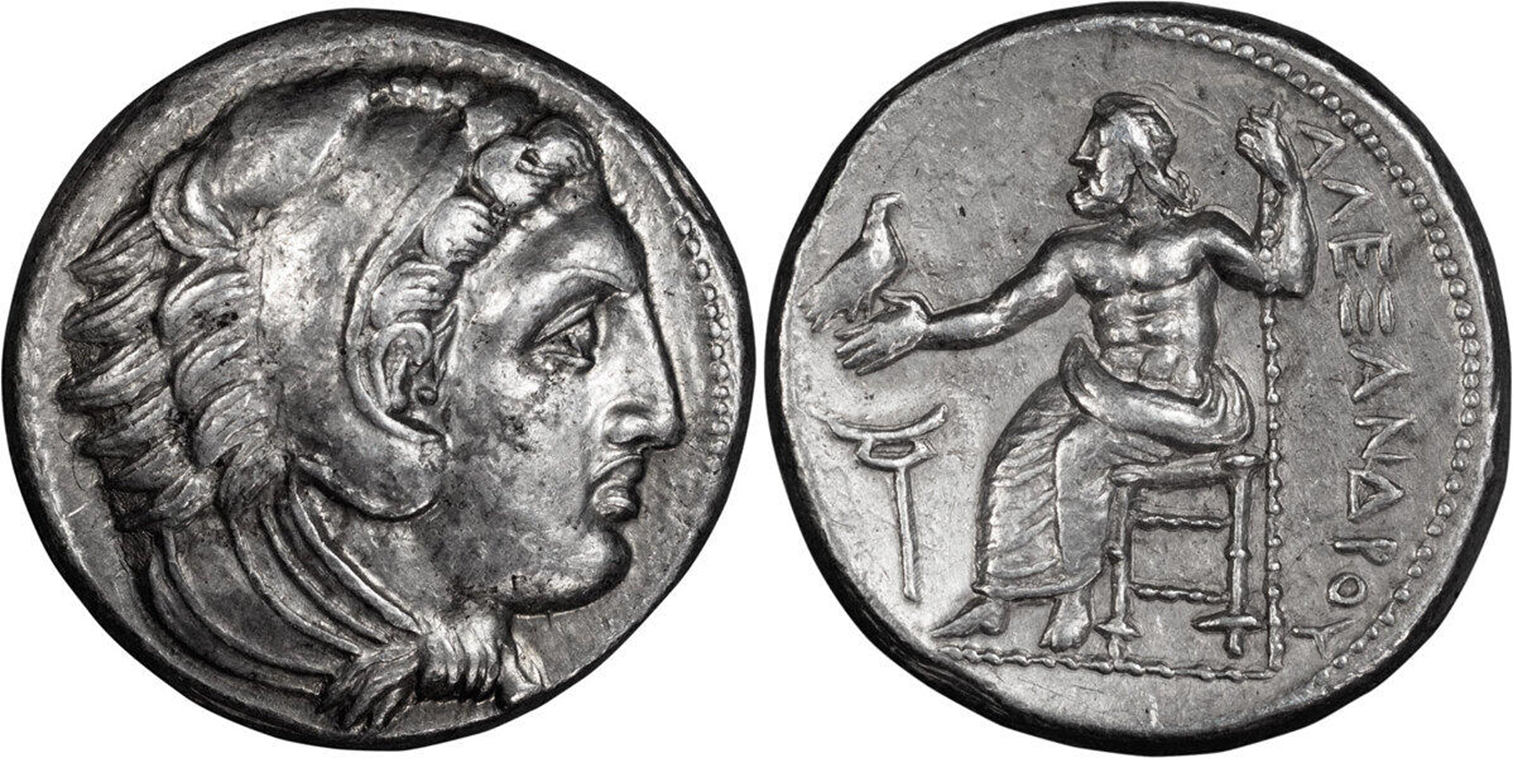
What do we know about this coin?
Tetradrachm of Alexander the Great (336-323 BC). Private Collection (Price-99
What does the coin depict?
Alexander on one side and Zeus on the other
What is this coin modelled on?
This is closely modeled on a persian coin (which wouldnt have depicted Zeus but a different god)
Is it truly Alexander on this coin?
This coin is often described as being alexander but it is infact a portrait of Hercales (wearing a lion skin), it will eventually become alexander
When did it become the dominant currency?
By the end of alexanders reign it was the dominant currency of greece and the near eastern world, largely because she used the Attic standard
How much money did Alexander give to his soldiers and where did this money come from?
In 324 BC Alexander paid a lot to his army the 10,000 soliders each recieved a talon each and he paid off the depths of his army (20,000 talons)
When Alexander captured the persian treasury it was 180,000 talons (only a few remained after all his spending)
What is next to Zeus on this coin?
Next to zeus on this coin is the name of the ruler, and the mint mark next to Zeus is a plough
What happened to coins after Alexander died?
After Alexanders death people continued to make coins bearing his name, they did this for political legitimacy they were linking themselves to him. Peoples also expected their coins to look familiar
Who did these coins begin to change under and how did they change?
These coins began to change under Tolomy, his coinage retained the rever image of alexander/heracles but had a new obverse with heracles facing right wearing an elephant skin and ramhorns. He replaced zeus with athena:
Show a picture of the new coins
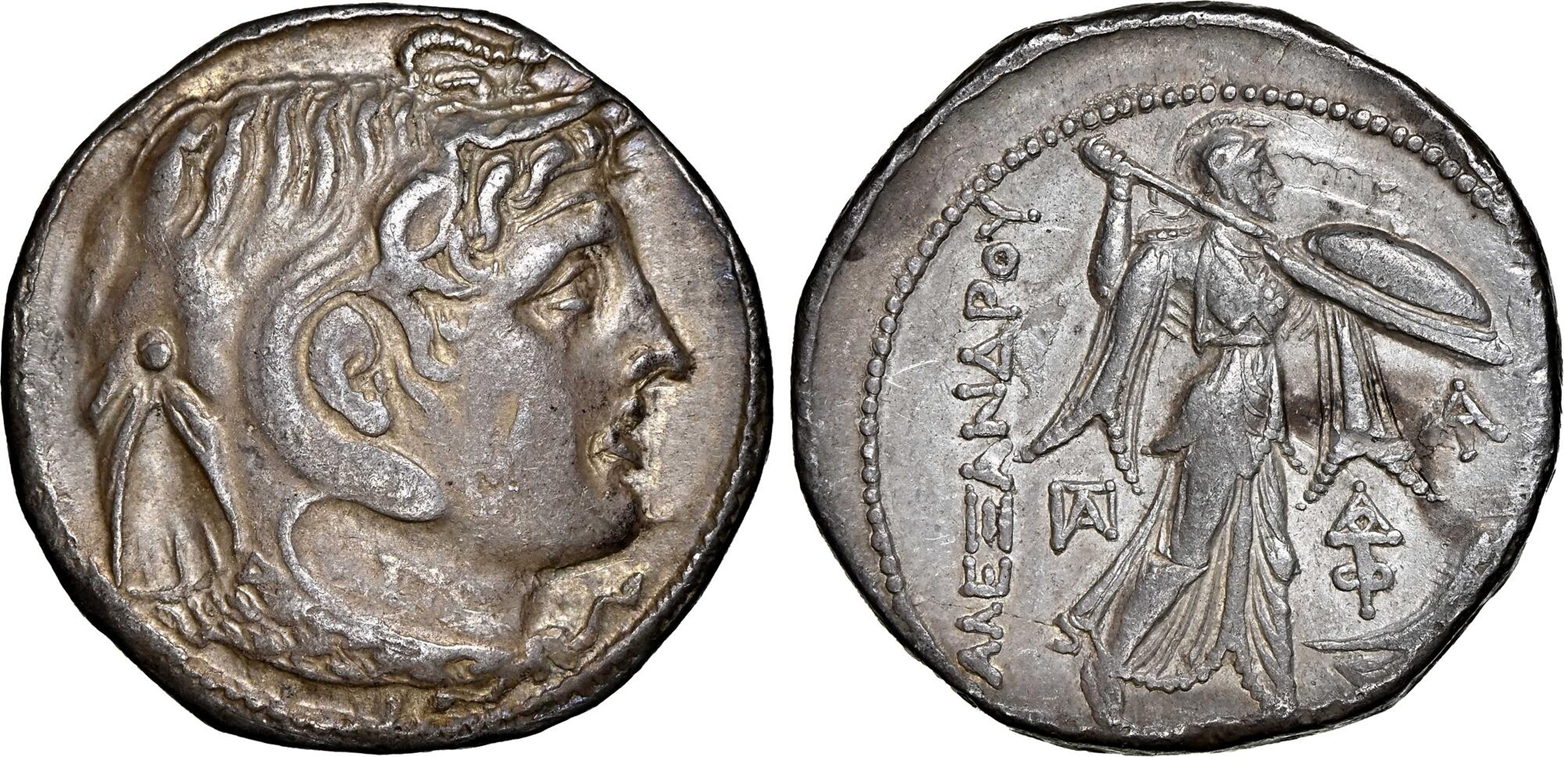
Describe the images on this coin:
Tetradrachm minted under Ptolemy I Soter (c. 306-300 BC). Obv: Diademed head of the deified Alexander right, wearing elephant’s skin headdress. Rev: AΛEΞANΔPOY - Athena Alkidemos advancing right, brandishing javelin and holding forth shield.
When did Ptolomey release his own coin and what was depcited on it?
Ptolomey eventually released his own portrait on coins, by 294 BC he had abandoned the alexander athena type and replaced it with his own face and an eagle on the other side.
Show this coin:

Tetradrachm of Ptolemy II Philadelphos (c. 262/1 BC)
Obv: Diademed head of Ptolemy I facing right; dotted border. Rev: ΠTOΛEMAIOY BAΣIΛEΩΣ - Eagle standing left on thunderbolt.
Why did Athenain coinage dominate?
•High Silver Content & Consistency Laurion silver mines provided an abundant supply.
•Reliable weight (17.2 g) and purity ensured trust in trade.
•Naval & Trade Supremacy Athens' dominance in the Delian League facilitated widespread circulation.
•Athenian fleets connected markets in Egypt, the Levant, the Black Sea, and Sicily.
•Political Influence in Subject Cities Athenian control led to the closure of local mints (e.g., Euboea).
•Athenian owls became the official currency in many regions.
Show the earliest roman republic coins:

Where was the coin produced?
Likely produced in Neapolis, modern day Naples
What were the coins made for?
The coins were likely created to support trade along the new route, however they follow greek methods of production and weighting
What was it the first roman coin to do?
The first roman coin uses the greek alphabet
What does the coin depict?
Obv. Head of Apollo. Rev. Forepart of a man-faced bull with eight- rayed star on the shoulder, ΡΩΜΑΙΩΝ (‘of the Romans’) above.
Show a silver roman drachma:
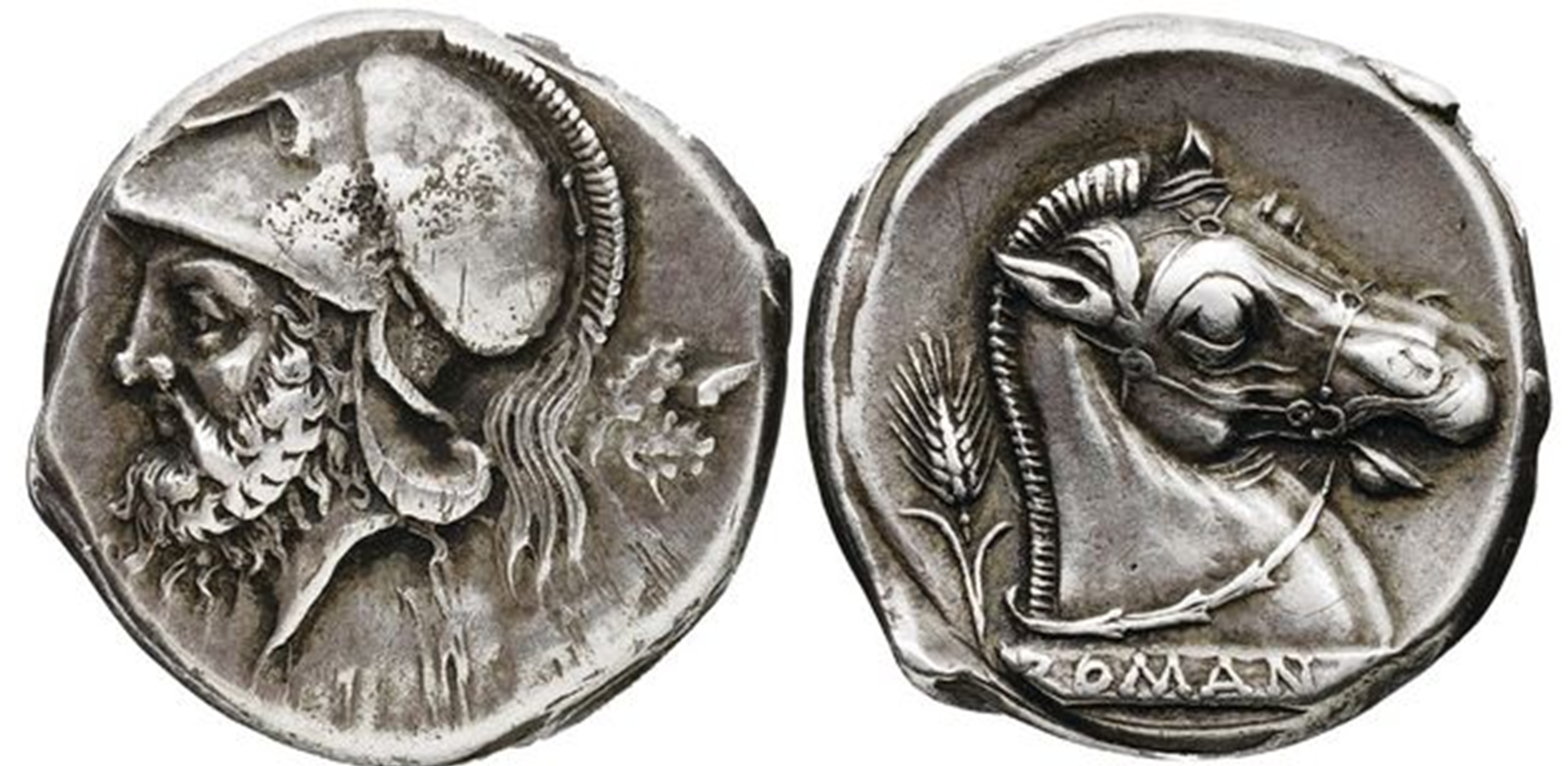
What does this coin depict?
Mars in a Corinthian helmet, oak leaves behind. Rev. Head and neck of a bridled horse; ear of wheat behind, ROMANO below
Why did Rome have to create a silver coin?
As rome waged war against people they had to pay their allies, this created the production of the first roman silver coin
What was the economic and political impact of the denarius?
Stabilizing the Economy
Introduced clear denominations, restoring confidence after periods of debasement.
Funding Military Expansion
Standardized silver coinage allowed for efficient soldier and ally payments.
Political Messaging on Coins
Depictions of Roma, the Dioscuri, and Jupiter reinforced Roman identity and power.
Exporting Roman Influence
The victoriatus facilitated trade in Greek economic networks without disruption.
What changed in the design of roman coins by the mind 2nd century?
BY mid 2nd C BC design of roman coins underwent a massive change in designs depicted on the coins. This shift also showed the tenseness and competition in roman politics
Over time the coins became self advertisement, allowing coins to be political propaganda.
A key moment in the revolution of coinage was when designs on coins varied a lot.
Why were depictions of buildings on coins important?
One of the most notable development was the depiction of buildings on coins, a communication of imperial achievements, unlike physical monuments which were conifned to where they were these coins could travel and therefore they could have a big impact on how rome was viewed
What flaws did these coins have?
While these depictions gave insight into their architecture they arent exact, they took artistic liberties to fit the monuments on the small surface of the coin. Sometimes we dont even know if these monuments were completed (if they ever were)
Show the Mars Ultor coins which depict monuments:
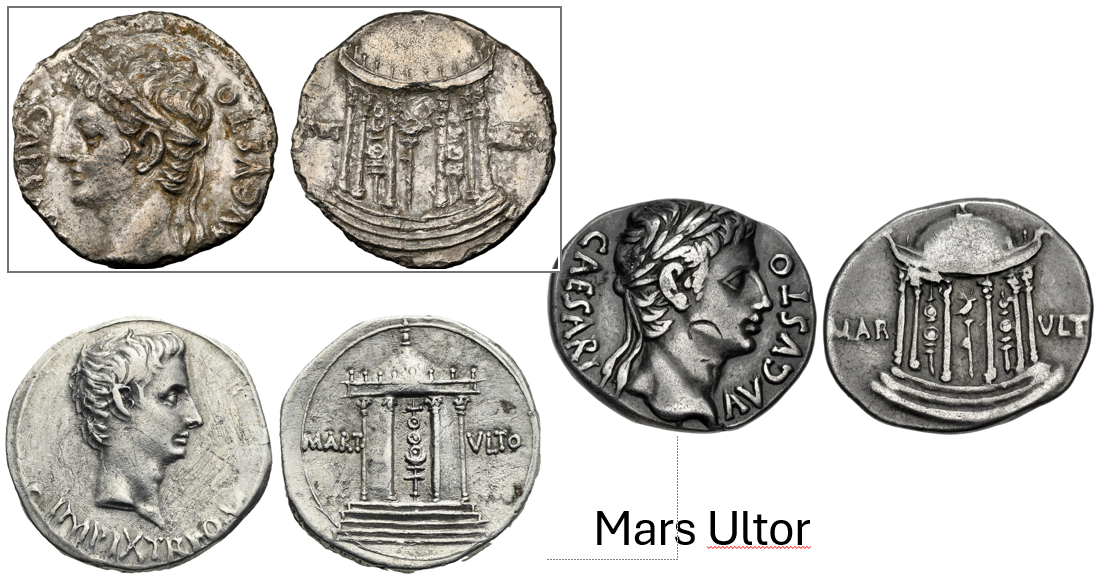
What do these coins tell us?
Reinforced image of a restorer celebrating his role as a builder and protector of rome
Even though all these coins depict the same place there are differences in shapes and the number of columns
What are some challenges in interpreting architectural imagery on coins?
•Artistic Simplification – Engravers used symbolic shorthand rather than architectural accuracy.
•Perspective Distortion – Flattened or foreshortened views make spatial reconstruction difficult.
•Symbolic Representation – Features like oversized statues or inscriptions emphasized political messages.
Who often accompanies depictions of bridges and roads on coins?
Depictions of bridges and roads on coins often have augustus with them
Show the coin where it depicts the ara pacis:

Give details of how the ara pacis is depicted on the coin:
Head of Nero, bare, right (globe at point of bust). (obverse)(obverse) Altar-enclosure (Ara Pacis) with ornamented top, decorated front panels and central double doors. (reverse)(reverse)
Show the coin which depcits the colosseum:
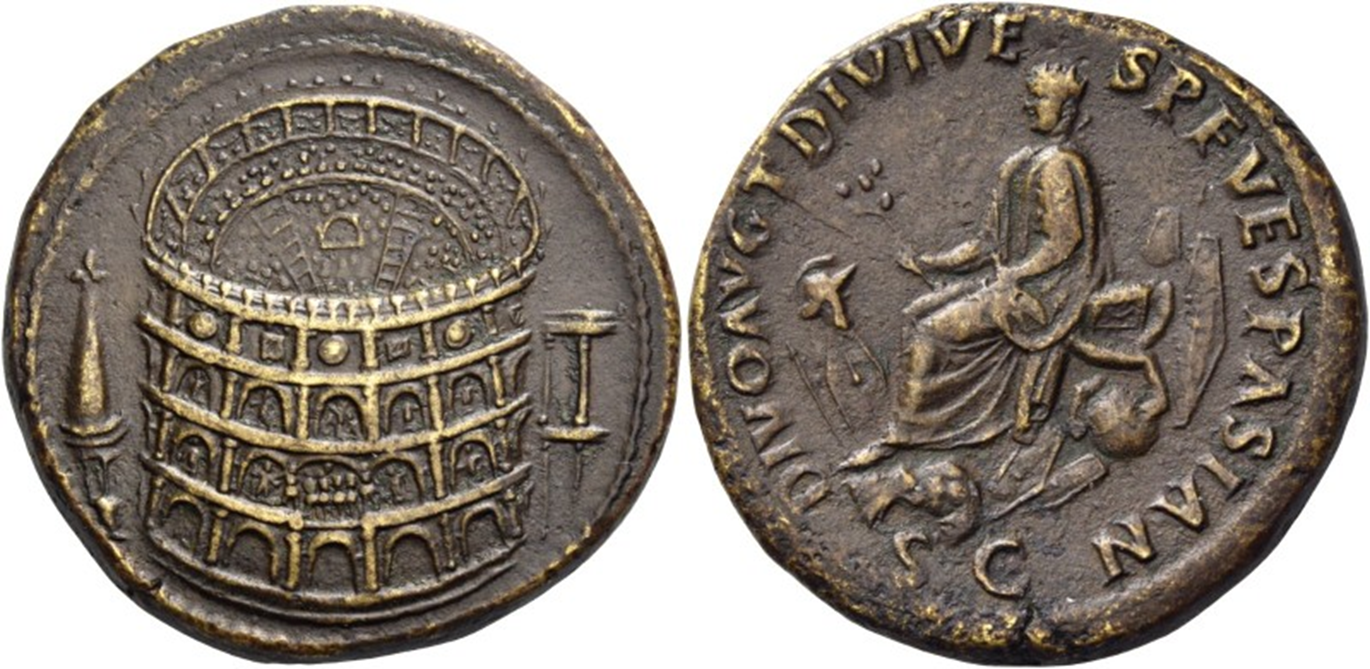
What does the obverse of the coin depict?
Flavian Amphitheatre, Meta Sudans l. field, porticoed building r. field.
What does the reverse of the coin depict?
DIVO AVG T DIVI VE-SP F VESPASIAN. Titus seated l. on curule chair, holding branch and roll; around, arms; below, SC.
RIC 131
What does the coin serve as?
Coin serves as a dinastic commemoration and celebrates the completion of the colosseum
What does the coin show us?
It shows us an aerial view of the colosseum, we can even see the heads of people in the colosseum
What are some precise details included in the coin?
Very exact, shows the reserved imperial viewing box